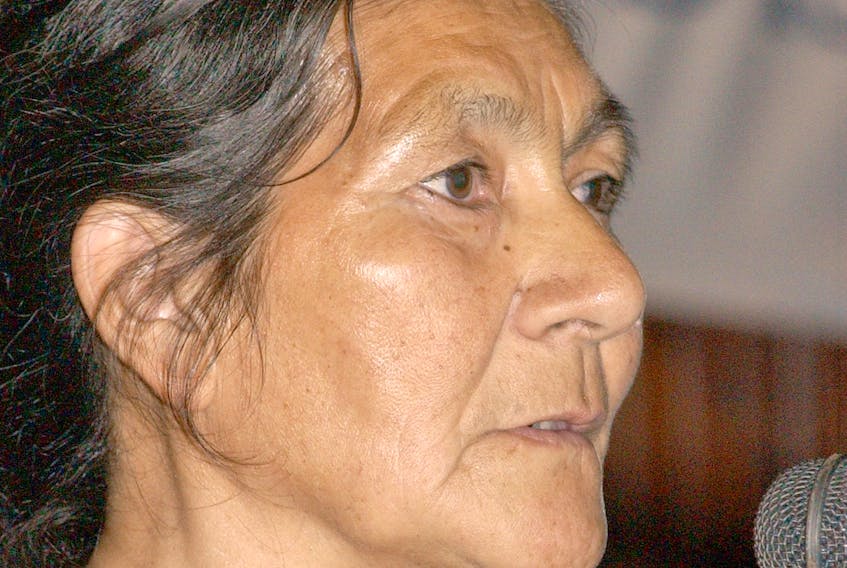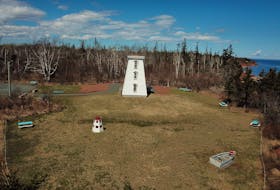SHESHATSHIU, N.L.
It’s taken many years to come to fruition, but well-respected Innu elder and environmental activist, Tshaukuesh Elizabeth Penashue is just months away from having her book “Nitinkikiau Innusi: I Keep the Land Alive,” published.

Co-edited and co-translated by Penashue and Elizabeth Yeoman of Memorial University’s Faculty of Education, the book is scheduled for release by the University of Manitoba Press in April 2019.
Speaking with her by phone from her home in Sheshatshiu, Penashue said she is very happy her book is going to be published.
“We talk about so many things (in the book) — going in the bush when I was young, in with my parents... when I stayed in the bush in the country with my family, then when I married, going in the bush with my children and my grandchildren. A lot of stories,” she said.
Penashue was a leader in the Innu campaign against NATO low-level flying on Innu land during the 1980s and ‘90s.
“Innu women never used to go out to meetings, but it was time to wake up and do something to stop the destruction caused by low-level flying and weapons testing,” Penashue writes in the Prologue to her book. “We started the spring walk and the summer canoe trip to teach people about our land and about the Mishta-shipu, the hydro projects.”
The 74-year-old also wrote, “When I first spoke publicly at Patshishetsuanau, a lot of people came to hear what I had to say... I went to the bombing range with other activists. We put tents on the base to protest. We were jailed many times, in Goose Bay and Stephenville. We walked from Toronto to Ottawa and they put us in jail there, too… I went to Europe twice to speak.”
Penashue has devoted her life to teaching people about Innu culture by sharing her story and knowledge of the land.
“Everything we do is to show the government that our culture and way of life are crucial for our survival,” she wrote. “We can’t go back to the old ways completely, but we must pass the knowledge and skills on to our children and grandchildren.”
In her introduction to the book, Yeoman writes about walking in the country with Penashue (who she refers to as Tshaukuesh).
Her descriptive writing style takes the reader along on the journey.
She wrote, “I could never have imagined how cozy it would be inside a tent in the wilderness at –30˚C or how happy we would be: insulated by fir boughs and caribou skins, listening to the crackling of the fire in the rusty stove, breathing the scent of resin and wood smoke, illuminated by the flame of a single candle, the stories and laughter gradually subsiding as people drifted off to sleep; and then in the morning, waking up to the soft murmur of voices, the hiss of the kettle, the comforting smells of frying fish and bannock.”
“Nor could I have known,” Yeoman writes “what it would be like to travel with a small band of people pulling all my belongings on a toboggan over frozen marshes and lakes, along forest trails and up into the mountains, under brilliant sunshine and through snowstorms; hunting and fishing for food, chopping chunks of ice from the river to melt for tea; the delicious warmth and comfort of it after a long day of walking on snowshoes.”
Yeoman writes about how Penashue’s outrage at the disruption of peaceful Innu life during the NATO occupation of Innu land in the 1980s and ‘90s led to her keeping a diary in Innu-aimun as a way of preparing herself for speeches, court appearances, and interviews with reporters.
“The longer Tshaukuesh wrote, the more she knew she had to publish her diary as a book, a record of Innu history by an Innu woman who had lived through perhaps the most tumultuous and challenging times her people had ever known,” Yeoman wrote.
“Nitinkikiau Innusi: I Keep the Land Alive” is an edited translation of Penashue’s diary and is illustrated with photos from professional photographers and journalists as well as archival images from Penashue’s own collection.
Penashue is the recipient of a National Aboriginal Achievement Award and an honorary doctorate from Memorial University. She has also been featured in documentary films, books, and in numerous articles.
It felt good to work on the book, she tells her readers. It’s her legacy to her people.
“So many women have helped and supported me; they were so kind and welcoming; they respected me and they helped me get the word out,” she wrote. “Women from many backgrounds and places, in many parts of North America and Europe, and in Labrador—when I’m at the bank or shopping, they come up to me to tell me they support my work. They give me courage to continue. Thank-you to all of them.”









